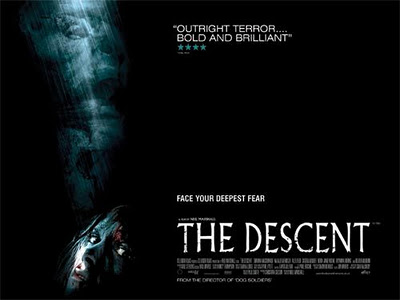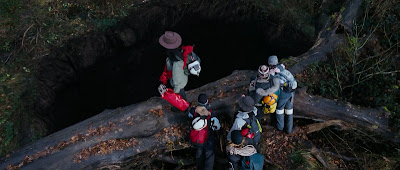When I first heard of The Descent, around the time of its 2006 theatrical release, it was described to me as “a movie about a bunch of lesbians who go into a cave and there are monsters.”
As it turns out, the entire six-woman cast of characters is ostensibly straight, if their boy talk in the early character-establishing scenes is anything to go by. I suspect my friend saw an all-female cast in a horror movie and assumed there MUST be lesbianism going on, because what’s a horror movie without sex? Or, for a more sexist explanation, chicks doing something interesting together without male supervision reads lesbian.
[Warning: If you are a group of friends in a movie, and you take a picture like this, at least half of you will be killed.]
Regardless, The Descent IS a movie about a bunch of women who go into a cave and there are monsters. What makes it such a brilliant movie is that you can chop the last three words off that plot description and you still have the makings of a terrific scary movie. It’s almost a full hour before the monsters appear, but that doesn’t mean the horror can’t start before the opening titles. After establishing a group of adventuresome female friends, we’re subject to witness the gruesome auto accident that kills main character Sarah’s husband and child. One year later, the friends have reconvened in the Appalachian mountains in the United States for a caving expedition to help a grief-wracked Sarah get her groove back. Only Juno, the alpha dog in the group (who just happened to have been schtupping Sarah’s husband before he was killed) knows that they are actually venturing into an unexplored cave system. In Juno’s mind, this surprise is an even greater gift to Sarah, who will get the honor of naming the cave system, perhaps after her dead daughter. But after a tunnel collapse blocks off their return path, Juno’s surprise means the group has no map and no one on the surface knows where they are.
Being trapped in an unknown cave with limited resources and no hope of outside rescue is in itself a terrifying situation, and The Descent plays it for all it is worth. A seemingly bottomless chasm must be crossed with only half the cams needed. One caver’s hand is sliced open by a ropeline when she saves her friend from plummeting to her death. Another caver follows the illusion of daylight, falls down a hole, and suffers a compound fracture in her leg. I’m already watching about half of the scenes through a finger screen and demanding that we turn the lights back on.
And then, the monsters come. Humanoid creatures with waxy pale skin, unseeing bleached-out eyes, and a tendency to rip people’s throats out and then chomp on their guts. Because the creature design is so simple, The Descent can afford to show them to us without your typical monster-movie restraint. And because the creatures are blind, we’re forced to endure several close-quarters silent standoffs recalling the T-Rex vs. Jeep scene in Jurassic Park. Only this is an R-rated horror movie, so some of those encounters end in stomach-turning gore.
All of this adds up to a horror movie so over-the-top terrifying I can’t believe I was willing to watch it again to write this review. But the gender implications of The Descent are too rich for me to deny, even though the film is sadly bereft of lesbians.
According to the iron-clad authority of Wikipedia, The Descent was originally conceived with a mixed-gender cast, until director Neil Marshall’s business partner “realized that horror films almost never have all-female casts.” But the female cast of The Descent brings more than novelty. I also don’t ascribe to Marshall’s suggestion that the chief advantage of the all-female cast is more naked emotion in a terrifying situation [“The women discuss how they feel about the situation, which the soldiers in Dog Soldiers [Marshall’s previous horror film] would never have done.”] The women of The Descent actually approach their situation with what is, at least to my American eyes, quite the stiff upper lip.
[Sidebar: Wikipedia also notes that Marshall gave the women different accents “to enable the audience to tell the difference between the women,” which is maybe the most depressing thing I’ve ever read. Who needs to bother with characterization when you have ACCENTS?]
I’m not buying the story that the all-female cast was to grab attention (if that were the case, maybe they would have been lesbians) or to allow for deeper exploration of feelings. I think the all-female cast of The Descent is designed to clue the audience into a particular subtextual layer to this horror story. Because what’s more terrifying than being trapped in a cave with monsters? Women. Women’s bodies.
While a cave setting evokes female reproductive organs almost inherently, the set design here takes this metaphor to extremes. The women descend into the cave through a slit-shaped gash in the earth, and then must crawl head-first through a narrow passageway into the greater cave system, where the true danger of the monsters await.
The monsters, depicted as the products of evolution motivated only by a primal drive for survival, are the perfect elaboration of this cave-as-womb horror metaphor. And as a cherry on top, they rip the guts out of these women.
Wait, the actual cherry on top is our heroine Sarah emerging Apocalypse Now-style from a pool of blood in the cave gallery that functions as the monsters’ killing fields, the signature image from the film. And the cherry on top of that cherry is that Sarah fights the only female creature in the film while still wading in the pool of blood and kills her by stabbing her in the face with a phallic bone.
After this menstrual baptism, Sarah shifts from a wounded woman paralyzed by grief into terrifying killing machine, fighting off the creatures so gruesomely it seems almost dangerously inefficient (Eye gouging? Really? They can’t even see!)
After all this, there’s still time for two more twists that rely on the gender of the cast for maximum effectiveness. [SPOILER ALERT, obviously.] First, we have Sarah in Creature Terminator Mode turn her rage against Juno, the only other human survivor, after discovering Juno’s affair with her late husband, by wounding her and leaving her to die at the hands of the creatures. It’s a moment that doesn’t sit quite right with me, in part because it is almost impossible to imagine a similar situation playing out between two male characters.
Shortly after this betrayal, Sarah escapes from the caves and is able to return to their parked vehicle. As she takes a moment to collect herself, she sees a bloody Juno in the passenger’s seat. In the American theatrical release, the film ends here, but in the original edit and the DVD Director’s Cut there’s an additional minute of footage where we see that Sarah’s entire escape was a hallucination, and she is still in the cave, with no exit in sight. Sarah then hallucinates her daughter sitting with her in the cave with a lit birthday cake, and looks peaceful and accepting as the camera pulls out to reveal the enormity of the cave and the great number of creatures closing in. I prefer this ending, not only because I’m a sucker for bleak endings. Throughout the film we’re given suggestions that Sarah’s grief is so great it has become a mental illness, including earlier depictions of hallucinations. And as much as I tire of cinema’s endless fascination with mentally ill women, in this case, it feels like a more honest character arc than the idea that fighting for survival and exacting cruel vengeance could snap her out of her grief haze.
Whether it was done to cash in on these female tropes, to underscore the metaphors to the female anatomy, or just to grab our attention, the all-female cast undeniably serves in The Descent’s favor. And it sure is a nice treat for us horror-flick loving bitches.
Robin Hitchcock previously reviewed Michael Clayton for Bitch Flicks. You can read more of her movie reviews at her blog HitchDied and plenty more feminist pop culture analysis at her other blog The Double R Diner.






“by wounding her and leaving her to die at the hands of the creatures. It’s a moment that doesn’t sit quite right with me, in part because it is almost impossible to imagine a similar situation playing out between two male characters.
One of my fave movies -Pitch Black – has this situation played out between two men. I won’t spoil it for people who haven’t watched so to keep it vague: Two men fight, one wound the other and leaves him to get eaten by monsters. So not completely impossible afterall. 😉
No joke, a dudebro I know described the Descent as a “chickflick” and cited the all-female cast as the reason…*facepalm*
Unfortunately, the actual depiction of caving in this film is so utterly terrible it obscures most of the plot for me. Who brings ice axes and cams underground (both worse than useless) but doesn’t bring spare lights/batteries, food or warm clothing (essential)? Even if Juno is nuts (which, yeah, because entering a new cave system requires survey gear and hella precautions), the rest of of them are depicted as moderately competant, and these are basic, basic things.
I get that there are monsters and it’s not real, but to my mind it’s much scarier when – as in ‘dog soldiers’ – the characters actually enter their environment fully prepared and with realistic precautions and still become ghoul chow.
Putting the women in little strappy tops – the worst imaginable clothing to go caving in – seemed obviously pandering to the male gaze in a really disappointing way, too.